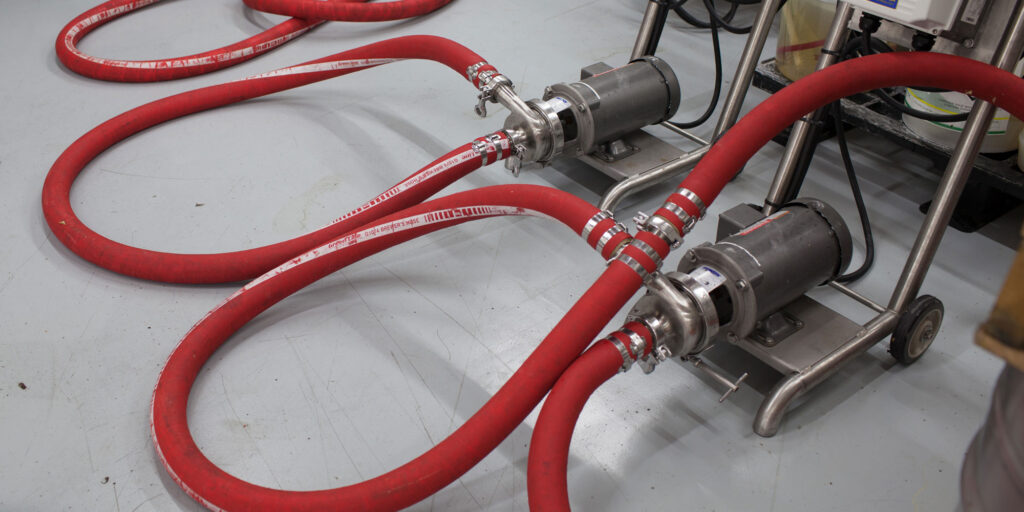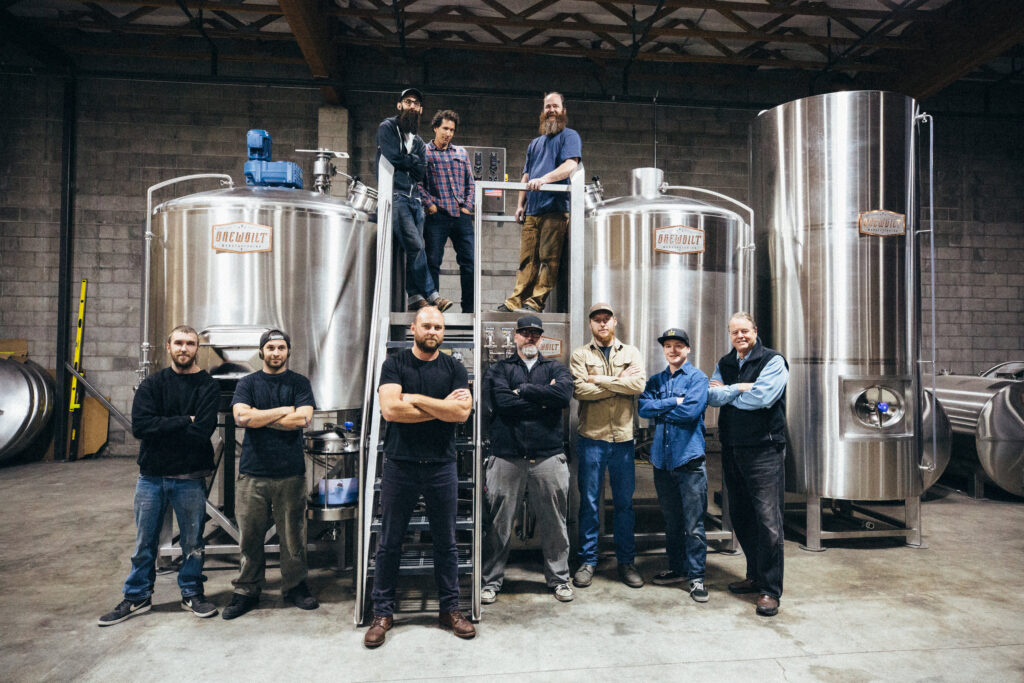
By: Alyssa l. Ochs
In the brewing industry, many different small parts play a significant role in producing beer. While hoses, tubes, clamps and connections are often overlooked, it is never a good idea to use worn-down or ill-fitting parts that could compromise the product’s quality. Brewers can benefit from learning about different types of hoses, tubes, clamps and connections to determine whether an upgrade is needed now or in the near future.
Types of Brewery Connection Products
There are various hose types and sizes that breweries use for different purposes. Commonly used hoses for beer operations include beer transfer hoses, washdown hoses, crush-proof hoses and general-purpose hoses. Hose widths are often between 1 and 4 inches, while hose lengths can be anywhere from 5 to 50 feet.
Meanwhile, tubes connect pieces of brewhouse equipment and work in conjunction with various piping components. Black pipes carry water into the brewhouse and out into the wastewater system, while stainless-steel pipes are used for many parts of the brewing process. Galvanized pipes coated with zinc are important for corrosion resistance. Copper pipes, ABS plastic pipes and polypropylene-R pipes are all common in breweries. For tubing, thick-walled vinyl tubing is the top choice of many brewers because of its kink-resistance, taste protection and flexibility even while cold.
One-inch crimped stainless-steel tri-clamp ends are useful in breweries, with typical sizes being a quarter-, three-eighths-, one-half-, five-eighths- and three-quarter-inch. Both plastic and metal clamps are used in breweries with cutter and crimping tools to ensure a good fit. Worm clamps are easy to find in hardware stores and operate with a screw mechanism and metal strap with slots cut into the strap. Easy to use and reusable, snap rings are clamps made with semi-rigid plastic that utilize pressure to tighten. Single- and double-eared clamps are circular and have ears that hold the strap in an open position until closed with pliers and cannot reopen. Meanwhile, stepless clamps apply equal pressure and require a tool to apply and remove, making them non-reusable.
Connections include basic hose connectors called barb fittings and easy-to-clean sanitary connectors called tri-clamps. Camlocks and stainless sleeve QD connectors allow a brewer to make connections without swapping hoses or removing or installing clamps on hoses.
James Lutgring, head brewer for Bayou Teche Brewing in Arnaudville, Louisiana, told Beverage Master Magazine that his team uses 1.5-inch tubing with 1.5-inch tri-clamp fittings for nearly everything in their brewery.
“These hoses are used for transferring wort and beer, cleaning, sanitizing and moving water around to where we need it,” Lutgring said. “We also use ½ inch silicon tubing when transferring beer to kegs.”
Rob Williams, sales manager for Alliance Hose & Rubber Co., said the company’s most popular products are custom length transfer hoses and specialty tri-clamp fittings.
“We offer several types, each having a unique advantage,” Williams said. “For example, there are hoses that are kink- and crush-resistant for higher traffic areas, while extreme-flex corrugated covers offer higher flexibility and allow the water to pass through the corrugations to prevent water damming.”
Also popular, he said, is Alliance’s washdown hose. “We offer hoses that have a high standard when it comes to cleaning and sanitizing. Our washdown hoses have the Microban cover, which does not allow bacteria to form on the cover, as well as FDA rated tubes. Finally, there are one-piece tri-clamp crimp elbows to reduce hose trip hazards and end damage to hoses used on manifolds. With the level of safety concerns and cleaning processes being updated daily, providing safe assemblies and best practices to help the brewing community meet or exceed their safety requirements is our goal.”
When to use Different Types of Connections
Experienced brewers know the best parts and accessories for different purposes, such as brewery suction and discharge applications. Concerning hoses, vinyl hoses are easy to obtain and use, but they can curl easily and accumulate residue inside. Reinforced vinyl hoses are stiffer but aren’t the best at handling high temperatures. For less curling and high-temperature resistance, many prefer silicone hoses. Good qualities in a brewery hose include flexibility, lightweight design, durability, ability to easily bend around brewing equipment, purity so that smells and tastes aren’t affected and a smooth structure that’s easy to clean.
For tubing, transparent tubes are good choices for seeing what is collecting inside the tube and perhaps even causing contamination. Tubes should withstand high temperatures and have thick walls for high pressure. Beverage-specific tubing is also designed to prevent curling.
Brewers often use tri-clamp fittings to move unprocessed beer from one place to another, leading to many variations being sold on the market today. Tri-clover, Camlock, Blichmann NPT and Quick Connect are the most commonly used connection types. Tri-clover fittings are sanitary, have a separate silicone seal and a tri-clamp that holds the pieces together. Blichmann NPT connectors require screwing in with each use, so they aren’t as quick to use, but they have a plastic sleeve that allows brewers to connect it without gloves, even when hot, and to connect and disconnect without leaks. Meanwhile, Camlocks are made from stainless steel, have a water-tight seal and are quick to connect and disconnect.
The Importance of Hoses, Tubes, Clamps and Connections
These small details add up when operating complex brewing machines and trying to make the best beer possible for consumers with minimal hassles for staff. Hoses, tubes, clamps and connections are all important because, when working correctly, they help preserve the intended taste and smell of the beer. The right parts also help staff work in confined spaces without feeling cramped or frustrated. Having working parts will also help maintain overall equipment investment. When these products aren’t checked and maintained regularly, serious leaks in the brewing space or tainted beer that is not safe or desirable to drink could result.
Williams from Alliance Hose & Rubber Co. said that the use of various hose and fittings is crucial since not all hose and fittings can handle the temperatures, pressures and chemicals present in the brewing process.
“There are many safety issues concerning the proper attachment methods – i.e., crimping, bands and clamps – used with the brewery hoses as well,” Williams said. “Brewers suffer a great deal of product loss and also personal injury every year due to the misapplication of hoses, tubes and fittings. Some stages of the brewing process can use the same type of hoses, such as the transfer of beer from one vessel to another in either the heating stage or to the kegging process. However, brewers who are also making sours, distilled liquors or seltzers will need to use specific hoses for these processes.”
For example, Williams said that brewers tend to use a different cover color and fitting when making sour beers.
“This ensures that the same hose is not used in the regular brewing process and that sour hoses are only used for sour beers,” he said. “When distilling or making seltzers, it is highly recommended that brewers use a higher-proof-capable FDA hose with a wire reinforcement so that the hose can be grounded to the system and not cause a potential fire hazard.”
Finally, Williams said that proper tubing and fittings should be used when higher concentrations of cleaning chemicals are in the brewing system or when transferring flavorings into the brewing process. Alliance Hose offers phone consultations – as well as on-site visits for breweries in the Elmhurst, Illinois area – to assist in selecting hoses and their safe use.
Choosing the Right Product
Some of the most common mistakes and oversights that breweries make regarding these products are over-use and not regularly checking on them. Other common errors are settling for the cheapest option and making do with multipurpose parts that don’t best serve specific needs. It’s also vital to remember that brewers will need tools to cut tubing and hoses and crimp clamps. Cutters and pincers are available in different sizes and should factor into a brewery’s overall equipment budget.
Lutgring from Bayou Teche Brewing said, “The hoses need to be able to withstand temperatures of 220 degrees Fahrenheit, caustics, acids and pressures of up to 200 psi, while also being durable enough to last.”
“Cost is also a big factor when we are shopping for new hoses,” Lutgring said. “The tri-clamp fittings are just about the same wherever you get them, so it usually comes down to price and convenience. Some of the valves may last longer than others, but you just have to learn that from experience with the vendor.”
Williams from Alliance Hose & Rubber Co. said breweries should get their S.T.A.M.P.E.D information to the hose and fitting supplier. “S.T.A.M.P.E.D. is an acronym used to get all the correct details of the application so that the safest and most proper hose and tubing system can be provided,” he said.
Here’s what the acronym stands for to help breweries be as safe as possible while using these products:
S = Size (i.d. and o.d.) and length.
T = Temperature (product transferred & atmosphere).
A = Application (what is the hose being used for).
M = Media (what is being transferred).
P = Pressure.
E = Ends (fitting type).
D = Delivery (how soon the product is needed).
Regarding safety, another resource is the Master Brewers Association of the Americas’ Safety Toolbox Talk that discusses hose fitting attachment methods in practical terms with helpful visual depictions.









